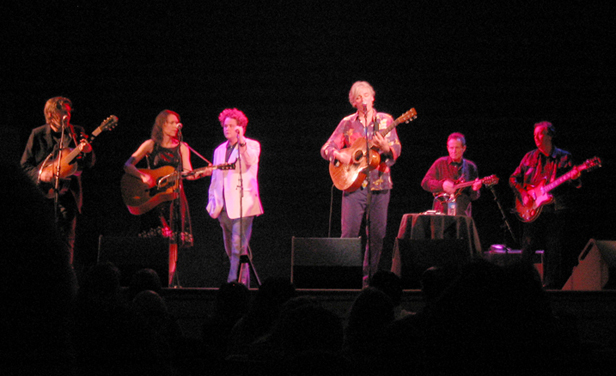Robyn Hitchcock and the Nashville Crawdads
W: The first concert we saw in 2007 was one of the best I have seen in my life. We drove to Nashville to see Robyn Hitchcock perform at the Belcourt Theater on March 18.
I don’t know whether we expected to see the Venus 3 performing together in support of their new album Olé Tarantula, but, wandering the neighborhood that morning, a local arts newspaper informed us that Hitchcock would be performing with a one-time-only ensemble that was calling themselves the Nashville Crawdads. The article hinted that it would be a special event.
The theater seemed to be an old-time movie theater—small, intimate, and with every seat a good seat. We sat no further back than the fifteenth row and were quite comfortable. The place was not even full. There was no opening act, just Robyn Hitchcock and a cast of characters blasting into “Adventure Rocket Ship”. Those characters, we learned, were Gillian Welsh and David Rawlings (oo! ah!), and Shawn Nelson from Harvey Danger on backing vocals. When Robyn Hitchcock announced that the old man hunched over a mandolin on stage right was John Paul Jones, Cristy poked me and hissed that it was the bassist from Led Zeppelin. I denied it. It’s a joke! It’s a common enough name—wasn’t there even a pope named that? But, sure enough, we came as close to seeing a Led Zeppelin concert as we would ever care to: an all-acoustic Robyn Hitchcock show.
C: I was pleasantly surprised to discover John Paul Jones playing mandolin. A classy professional—the true “musician’s musician”—he was content to let the others shine as he embellished Hitchcock’s songs with beautiful, ringing accents.
I came to this concert knowing only a fraction of Robyn Hitchcock’s repertoire—Ole Tarantula, the song “1974,” which was part of the new-music repertoire on my college radio station in 1998, and a failed attempt at liking Perspex Island in seventh grade.
William’s enthusiasm for the show was contagious, and Robyn Hitchcock is...well...he’s lanky, British, and impossibly cute. Not to sound sexist, but I figured at the very least I’d enjoy two hours of eye candy.
R.E.M.’s Peter Buck played guitar, but instead of acting as a support, like Jones, he stayed to the side of the stage, almost as if he wanted to disappear. He often looked down, or in other directions, and his poker face was almost mask-like. Even though his efforts may have been stellar, his reluctant presence made his guitar playing nondescript.
Other than Buck, the musicians had a solid chemistry. It was as if the audience had happened upon a fun jam session. Even if you weren’t familiar with many songs (like me), Hitchcock’s voice was clear, he had great rapport with the audience, and he was gracious, frequently recognizing his fellow musicians.
The highlight for me was a cover of the Grateful Dead’s “Candyman” (and I’m not even a Grateful Dead fan!). The harmonies were flawless and smooth as cream.
W: Right, I forgot about the stoic Peter Buck, who never even warmed up enough to remove his leather jacket. There were many covers. We’ll provide a complete setlist below, but the songwriters represented were, in order of magnitude, Robyn Hitchcock, Bob Dylan, Gillian Welch, and, yes, the Dead, with the cover of “Candyman” feeling a bit under-rehearsed, but, with Hitchcock’s John Lennon-meets-Vincent Price vocal style, more appropriately sinister than the giddy, effervescent Dead feel.
C: I think Bob Dylan goes last in that list, but that’s a whole new can of worms.
W: Um, by “magnitude,” I meant number of songs performed, not perspicacity. (For a reference here on Cristy’s ’tude re. Dylan, interested readers may see Bands We Should Like But Don’t.) Hitchcock sang lead on most all songs, though possibly everybody contributed backing vocals of some kind. This meant that Robyn Hitchcock sang Welch’s “Elvis Presley Blues” (excellent, although he may have misremembered some of the verses) and a chilling “Miss Ohio.” Robyn Hitchcock can be counted on to provide usually surreal, sometimes insightful between-song banter, and he kept comparing the Nashville Crawdads to the Weavers, with much amusing commentary on the genre known as “folk”. There was an elaborate introduction to “(A Man’s Gotta Know His Limitations) Briggs” that established that the song was inspired by a Dirty Harry movie, though it’s not clear whether we should believe that. I guess an Eastwood fan would have to decide whether that’s credible.
C: Is “between-song banter” ever referred to as anything other than “banter”? I think that term is featured in every concert review I’ve ever read.
W: I don’t know, Cristy.
SETLIST
Tamarlane
Adventure Rocket Ship
Olé Tarantula
Balloon Man
Flesh Number One (Beatle Dennis)
Tiny Montgomery, by Bob Dylan
Lo and Behold / Life During Wartime, by Bob Dylan / Talking Heads
Elvis Presley Blues, by Gillian Welsh
Queen Elvis
Brenda’s Iron Sledge
Flanagan’s Song
Copper Kettle, by Bob Dylan
(A Man’s Gotta Know His Limitations) Briggs
American Girl
I Wanna Destroy You
encore
Miss Ohio, by Gillian Welsh
Candy Man, by the Grateful Dead
Television
Acid Bird
Queen Jane, by Bob Dylan



